| |
Investigation |
The Science |
 |
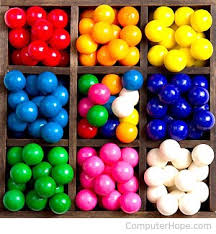 |
Sorting and Classifying |
The ideas of classifying and sorting are at the heart of much of science - making patterns and organising. So, we have alive, not alive and never alive, or vertebrates or invertebrates, or types of mammals are ways of organising and sorting living organisms. Transparent, Translucent or Opaque for how much light is let through. Science also likes scales such as the centigrade scale for temperature of the Scoville scale for strength of spice. This organisation or taxonomisation has given us some key science discoveries such as the periodic table or the classification of living things. |
 |
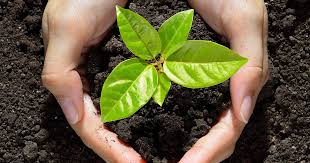 |
Growing a plant |
Plants need some key things to grow. Light, Soil (or a nutrient source) water and air. You can grown plants without soil in a water / nutrient mixture (hydroponics) a key science for the future and for space travel. Plants also change carbon-dioxide into oxygen via gas exchange - this is the oxygen that is vital for animals (including us!). |
 |
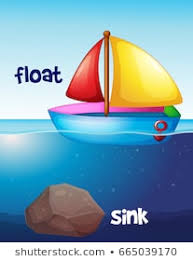 |
Floating and Sinking |
When an object is in a fluid (liquid of gas) it pushes (displaces) some of that fluid. The gravity effect on that displaces fluid gives the object an upward push. If that is bigger than the gravity force on the object it floats (e.g. helium balloon in air is lighter than the air it pushes out of the way). A hollow boat will push a lot of water out of the way and so will float even though the boat is made of heavy metal. |
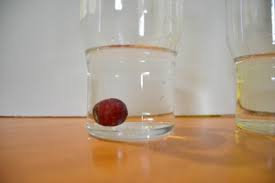 |
Floating Grape |
So the "magic" grape is a little denser (mass/volume or amount of stuff / amount of space) than tap water but when you add enough salt to the water the salty water becomes more dense than the grape. So when you start the water pushed out of the way has less gravity force than the grape so it sinks - later on the salty water has more so it floats - science not magic! |
 |
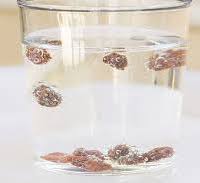 |
Dancing Raisins |
Bubbles of carbon-dixode will form in the wrinkles of the raisins (lots of surface area and points for them to form on called nucleation points) They act like tiny flotation devices that lift the raisin to the surface of the water. This is due to an increase in buoyancy. Once the carbon dioxide bubbles reach the surface of the soda they pop and the gas is released into the air. This makes the raisin lose buoyancy and fall back down to the bottom of the glass. |
 |
 |
Water on a penny |
There are two things going on here. The attraction between water molecules is called cohesion. The cohesive force that occurs between water molecules is so strong that, at the water's surface, it creates a "skin", which is known as surface tension. The attraction of water molecules to other substances, like soil or glass, is called adhesion. As drops of water are added onto a penny, the adhesive force between the water and the penny keeps the water from falling off. The cohesive forces between water (polar) molecules are stronger than those between non-polar molecules, such as those in oil or syrup. That's why you can make a bigger "pile" of water than of oil or syrup. |
 |
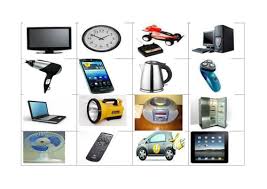 |
Checking out the power |
Electricity comes into our houses in two forms - power in the wires that has been produced in a generator far away produced by mechanical means (a magnet turning inside a coil of wire) or in a cell (battery) produced by a chemical reaction. The mains gives us more power (volts) but the battery is portable power. We can also get portable generators - you may have a "wind up torch" this is a small portable generator (which you operate by hand [mechanical] and it charges a battery [chemical]) |
 |
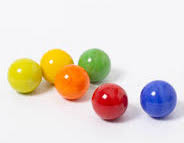 |
Marble runs |
Gravity pulls any object with mass towards the centre of the earth (all masses attract each other and the earth is very massive). So as long as your marble run (mostly) points down the marbles will keep going. When the are moving they do 'store' movement energy (momentum) so they can use this to go against gravity for a little. Can you make your marble hop, skip and jump. If the surfaces the marble is running along are smooth (low friction) then they will not slow down (if they are rough (high friction) they will slow down quickly and may stop! |
 |
 |
Tallest Tower |
Objects can be made rigid (do not bend) or flexible (do bend). Sheets of paper are very flexible but not strong. So by making tubes (or using ready made tubes [straws]) we create strong, rigid materials. However we do not want these to be damaged bent or they lost the structural integrity and will be flexible again at the point of the bend. We also want the centre of gravity (the point at which the mass of the object acts) to be inside the framework of the tower - if it is outside the tower will be subject to a turning force and will topple. This is why towers tend to be pyramids or cuboids so that this centre of gravity is in the best place. |
 |
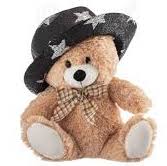 |
Keeping Teddy Dry |
Some objects do not let water flow through them (impermeable) whereas some objects let water through (permeable). There is a scale of permeability though so some will 'resist' for a while before letting the water through. We like to use impermeable objects to keep the rain off (plastics, leather, nylons are all good. |
 |
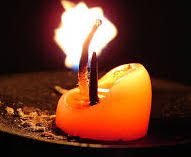 |
Burn, baby burn! |
In order to burn there needs to be oxygen and fuel and a 'starter' (usually a flame). Some things burn (combine with the oxygen to make a new substance) more easily than others. Fats and oils burn very well and foods that contain them will burn. Others, like those that contain water, do not burn so well or at all. |